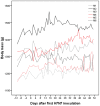Influenza virus in a natural host, the mallard: experimental infection data
- PMID: 20126617
- PMCID: PMC2812492
- DOI: 10.1371/journal.pone.0008935
Influenza virus in a natural host, the mallard: experimental infection data
Abstract
Wild waterfowl, particularly dabbling ducks such as mallards (Anas platyrhynchos), are considered the main reservoir of low-pathogenic avian influenza viruses (LPAIVs). They carry viruses that may evolve and become highly pathogenic for poultry or zoonotic. Understanding the ecology of LPAIVs in these natural hosts is therefore essential. We assessed the clinical response, viral shedding and antibody production of juvenile mallards after intra-esophageal inoculation of two LPAIV subtypes previously isolated from wild congeners. Six ducks, equipped with data loggers that continually monitored body temperature, heart rate and activity, were successively inoculated with an H7N7 LPAI isolate (day 0), the same H7N7 isolate again (day 21) and an H5N2 LPAI isolate (day 35). After the first H7N7 inoculation, the ducks remained alert with no modification of heart rate or activity. However, body temperature transiently increased in four individuals, suggesting that LPAIV strains may have minor clinical effects on their natural hosts. The excretion patterns observed after both re-inoculations differed strongly from those observed after the primary H7N7 inoculation, suggesting that not only homosubtypic but also heterosubtypic immunity exist. Our study suggests that LPAI infection has minor clinically measurable effects on mallards and that mallard ducks are able to mount immunological responses protective against heterologous infections. Because the transmission dynamics of LPAIVs in wild populations is greatly influenced by individual susceptibility and herd immunity, these findings are of high importance. Our study also shows the relevance of using telemetry to monitor disease in animals.
Conflict of interest statement
Figures






Similar articles
-
Effect of different routes of inoculation on infectivity and viral shedding of LPAI viruses in mallards.Avian Dis. 2012 Dec;56(4 Suppl):981-5. doi: 10.1637/10151-040812-ResNote.1. Avian Dis. 2012. PMID: 23402123
-
Variation in viral shedding patterns between different wild bird species infected experimentally with low-pathogenicity avian influenza viruses that originated from wild birds.Avian Pathol. 2011 Apr;40(2):119-24. doi: 10.1080/03079457.2010.540002. Avian Pathol. 2011. PMID: 21500030
-
Influence of body condition on influenza A virus infection in mallard ducks: experimental infection data.PLoS One. 2011;6(8):e22633. doi: 10.1371/journal.pone.0022633. Epub 2011 Aug 16. PLoS One. 2011. PMID: 21857940 Free PMC article.
-
Is there a relation between genetic or social groups of mallard ducks and the circulation of low pathogenic avian influenza viruses?Vet Microbiol. 2014 Jun 4;170(3-4):418-24. doi: 10.1016/j.vetmic.2014.03.001. Epub 2014 Mar 12. Vet Microbiol. 2014. PMID: 24690373
-
Host Range of Influenza A Virus H1 to H16 in Eurasian Ducks Based on Tissue and Receptor Binding Studies.J Virol. 2021 Feb 24;95(6):e01873-20. doi: 10.1128/JVI.01873-20. Print 2021 Feb 24. J Virol. 2021. PMID: 33361418 Free PMC article.
Cited by
-
The roles of migratory and resident birds in local avian influenza infection dynamics.J Appl Ecol. 2018 Nov;55(6):2963-2975. doi: 10.1111/1365-2664.13154. Epub 2018 Mar 26. J Appl Ecol. 2018. PMID: 30337766 Free PMC article.
-
Avian influenza infection alters fecal odor in mallards.PLoS One. 2013 Oct 16;8(10):e75411. doi: 10.1371/journal.pone.0075411. eCollection 2013. PLoS One. 2013. PMID: 24146753 Free PMC article.
-
Molecular Evolution of the Influenza A Virus Non-structural Protein 1 in Interspecies Transmission and Adaptation.Front Microbiol. 2021 Oct 4;12:693204. doi: 10.3389/fmicb.2021.693204. eCollection 2021. Front Microbiol. 2021. PMID: 34671321 Free PMC article. Review.
-
Heterosubtypic immunity increases infectious dose required to infect Mallard ducks with Influenza A virus.PLoS One. 2018 Apr 26;13(4):e0196394. doi: 10.1371/journal.pone.0196394. eCollection 2018. PLoS One. 2018. PMID: 29698449 Free PMC article.
-
Adaptive Heterosubtypic Immunity to Low Pathogenic Avian Influenza Viruses in Experimentally Infected Mallards.PLoS One. 2017 Jan 20;12(1):e0170335. doi: 10.1371/journal.pone.0170335. eCollection 2017. PLoS One. 2017. PMID: 28107403 Free PMC article.
References
-
- Olsen B, Munster VJ, Wallensten A, Waldenstrom J, Osterhaus AD, et al. Global patterns of influenza a virus in wild birds. Science. 2006;312:384–388. - PubMed
-
- Slemons RD, Easterday BC. Virus replication in the digestive tract of ducks exposed by aerosol to type-A influenza. Avian Dis. 1978;22:367–377. - PubMed
Publication types
MeSH terms
LinkOut - more resources
Full Text Sources
Medical

